Learning Outcomes
After this course learners will be able to:
- Explain the rationale for evaluating remote microphone performance using farther talker-listener distances.
- Describe how varying the distance between the talker and remote microphone impacts potential benefit.
- Identify the conditions where the remote microphone is most effective.
Introduction
Remote microphone (RM) technology transmits the target signal of interest to the listener wirelessly through dedicated receiving devices such as earbuds, hearing aids (HA) or cochlear implants. It uses different transmission protocols such as Frequency Modulations, standard Bluetooth or proprietary streaming (2.4 GHz). RM technology has been evaluated in our profession since the early 1980’s (Hawkins 1984), and its efficacy in improving the signal-to-noise ratio (SNR) of the listening environments has been repeatedly demonstrated (Boothroyd 2004; Jerger et al, 1996; Maidment et al, 2018).
The basic principle of RM technology is that it overcomes the negative effects of talker-listener (T-L) separation that occurs to varying degrees in real-life communication situations. These negative effects include a decrease in signal-to-noise ratio (SNR) from the decreasing signal level and an increased contamination from the reverberation and any interfering noise between the talker and the listener. These negative effects increase as the separation between the talker and the listener increases.
Recently, Widex introduced the Widex Sound Assist™ remote microphone device. The Sound Assist (SA) is a multifunctional hearing accessory that connects wirelessly to the Widex Moment™ and Widex Moment Sheer™ hearing aids (Bluetooth protocol 4.2). The device measures 1 ¾ inch x 1 ¾ inch x ¾ inch (4.3 cm x 4.3 cm x 1.6 cm) and can be either clipped on to the speaker’s clothing (Partner mic) or placed onto a tabletop as a conference microphone (Tabletop mic). In addition, it allows for hands-free use with the listener’s smartphone, for streaming content from the phone or computer as well as for having an embedded T-coil to pick up inductive signals. When used in the Partner mode, an accelerometer within the device signals a vertical position and activates a front-facing mic for maximum speech sensitivity. When used in the Tabletop mode, the three-microphone array on the RM detects the spatial location of the talker and activates the adaptive beamformer within for maximum directivity. Alternatively, the listener can manually override the adaptive mic for a fixed polar pattern in the Tabletop mic mode. However, fixed polarity could compromise the audibility of a talker speaking from the direction outside the directional beam. The potential efficacy of the Sound Assist in preserving the SNR of the listening environment was evaluated in this study.
The rationale for a RM would suggest that studies which evaluate its efficacy should include a consideration of distance in its design in order to have a more complete picture of its efficacy. More specifically, a design that includes varying talker-listener (T-L) distance could shed light on how much difficulty listeners have at various T-L separations and how much benefit the RM confers at the different T-L separations. If the RM is evaluated only with a small T-L separation, the benefit in situations with greater T-L situations will be underestimated. A design that includes varying the talker-RM distance could inform us how far the RM may be placed away from the talker for one to still expect benefit. If the RM is evaluated only at a small distance from the talker, the benefit in situations with greater talker-RM separation will be over-estimated. Thus, the clinicians’ understanding of the distance effect could allow them to instruct their patients adequately so the patients receive the most benefit from the RM.
The research questions asked impact the test measures used in the evaluation. For example, when one is interested in knowing the improvement in speech understanding at real-life SNRs brought by the RM, one designs studies that test at fixed SNRs that resemble real-life conditions. Typically, these SNRs would range between 5 and 15 dB (Wu et al, 2018). A problem with using fixed test levels is the potential floor and ceiling effects which may under-estimate the potential benefit. On the other hand, if one is interested in the potential efficacy of the RM, adaptive tests may be more appropriate to overcome potential floor and ceiling effects. Adaptive speech tests alter the signal or the noise level to estimate the SNR for a fixed criterion of performance (such as speech reception thresholds for 50% correct, SRT50).
The objective of the current study was to evaluate the efficacy of the Sound Assist when used with Widex MOMENT hearing aids in various test conditions at a fixed but farther talker-listener distance than what is typically used in RM studies. Specifically, we asked the following questions.
- First, in a reverberant, diffuse noise situation, what is the required SNR for an aided SRT50 when T-L separation is 13 ft (or 4 m)?
- Second, what is the SNR advantage of the Partner mic when used with the MOMENT hearing aids compared to the hearing aid alone condition at a vertical distance between the SA and the sound source of 3 inches (7.6 cm), 6 inches (15.2 cm) and 9 inches (22.9 cm) from the talker/loudspeaker source?
- Third, what is the SNR advantage of the “Tabletop mic” when used with the MOMENT hearing aids over the hearing aid alone condition at a horizontal distance of 1 ft (0.3 m), 2 ft (0.61 m) and 4 ft (1.22m) from the talker/loudspeaker source when used in the fixed directional mode?
- Fourth, what is the advantage of the adaptive directional mic over the fixed directional mic with front and side talker locations?
- Fifth, what is the advantage of the Tabletop mic when noise is mostly confined near the listener (i.e., semi-diffuse vs fully diffuse)?
Method
Participants
Listeners included 19 hearing-impaired adults (mean age = 75.94 years, SD ±10.4; 11 male) with symmetrical bilateral sensorineural hearing loss sloping from moderate to severe (Figure 1). Fourteen listeners were current hearing aid wearers with 2.5 to 30 years of experience. One listener wore behind-the-ear style hearing aids and the remaining 13 wore receiver-in-the-canal hearing aids. All hearing-aid wearers reported wearing their hearing aids during most of their waking hours, with a mean of 12.5 hours daily. All participants passed the Montreal Cognitive Assessment (MoCA) test (average = 26.5). The study was approved by an independent Institutional Review Board (IRB). All subjects signed an informed consent prior to the study.
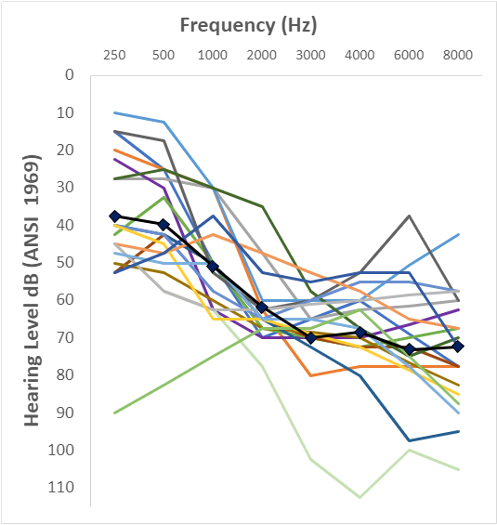
Figure 1. Air conduction thresholds for each listener (averaged for right and left ears). Average audiogram is represented by the dark line connected with diamonds.
Hearing Aid and Sound Assist Settings
All subjects were fitted binaurally with the Widex MOMENT hearing aids in the default settings using the NAL-NL2 prescriptive formula (experienced level) with no additional fine-tuning. All subjectively confirmed that the hearing aids were neither too loud nor too soft. The appropriate m- or p-receivers were used depending on the severity of the hearing loss. All subjects used the double-dome occluded instant eartips during the test.
The SA was used in the Partner mic mode when held in the vertical position (with front mic pointing upwards) and Tabletop mic mode when placed in a horizontal position. There was a volume control on the SA which controlled the relative gain provided by the SA and HA. In this study, the default setting (equal gain) was used.
Stimulus and Test Materials
High context (HC) sentences from the Repeat-Recall Test (RRT, Kuk et al 2020) were used to estimate the SRT50. During the test, the 210 sentences were randomized, and 21 sentences were used in a trial to estimate the required SNR for the SRT50. A custom Quest+ procedure (Watson, 2017) was used to adaptively change the level of the continuous speech-shaped noise in order to estimate the performance-intensity function from which the SRT50 was estimated. A fixed speech level of 65 dBA measured at the subject’s position was used.
Test Set-Up and Conditions
Listeners were seated in the middle of a classroom (40 ft x 20 ft x 10 ft or 12 m x 6 m x 3 m) with a measured reverberation time of 500 ms and an ambient noise level of 43 dBA. Stimuli were amplified and delivered by a Rotel RMB 1048 power amplifier connected to KRK ST-6 loudspeakers. Two loudspeakers were placed behind the listener and two were placed in front of the listener, next to a fifth loudspeaker from which the target speech signal was presented (Figure 2). A 0° azimuth speech loudspeaker was placed 13 ft (4 m) directly in front of the listener. A 60° azimuth side speech loudspeaker was also 13 ft (4 m) from the listener, but to the right of center. Noise loudspeakers were placed 6.7 ft (2 m) towards the center of the room from the perspective of the listeners’ front and back, and 3.3 ft (1 m) from the left side. Loudspeakers at each end of the room were 10 ft (3 m) apart from each other. Front and back loudspeakers were 23 ft (7 m) apart. Noise loudspeakers were turned towards the walls away from the listener to create a diffuse field.
The following conditions were tested:
- Aided with the MOMENT hearing aid alone.
- Aided with the MOMENT hearing aids paired to the SA and used in the Partner mic mode with the SA at fixed distances of 3 inches (7.6 cm), 6 inches (15.2 cm) and 9 inches (22.9 cm) below the lower edge of the cone of the speech loudspeaker. These distances approximate the separation between the SA and the talker’s mouth when the SA is worn near the collar of the listener’s shirt (3 inches or 7.6 cm) and at the limit of the lanyard that comes with the SA device (9 inches or 22.9 cm).
- Aided with the MOMENT hearing aids paired to the SA in the Tabletop mic mode and placed at 1 ft (0.3 m), 2 ft (0.61 m) and 4 ft (1.22m) from the speech loudspeaker in the fixed directional mode. At the 2 ft (0.61m) separation, the Tabletop mic was tested in the adaptive mic mode and with speech presented from 60o azimuth and with the noise behind the speech loudspeaker turned off.
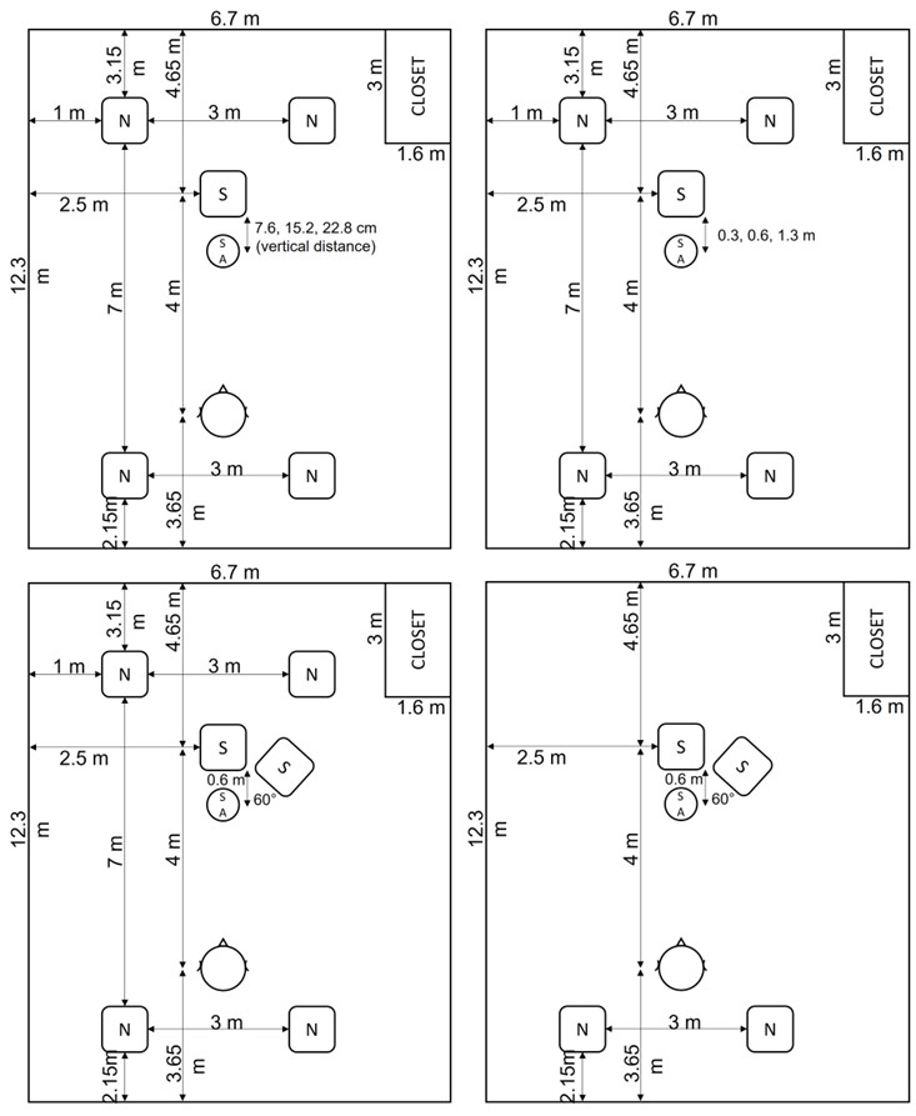
Figure 2. Test room configuration for the different test conditions: Partner mic (top left), Tabletop mic (top right), Tabletop mic with speech from the side (bottom left), and Tabletop mic back noise only (bottom right). The 4 loudspeakers presenting noise are indicated with an ’N’, while those used to present speech are indicated with an ’S’.
Procedure
All testing was completed within a single two-hour session. After otoscopy and audiometry, subjects were fitted with the MOMENT hearing aids and adequate loudness and comfort were ensured. Testing started with estimating the SRT50 for the hearing aids alone condition first to gauge the optimal range of SNRs for use during the Quest+ adaptive procedure for the other test conditions. Adaptive speech testing with the RRT materials for the other HA+SA test conditions was counterbalanced across test subjects.
Results
Required signal-to-noise ratios (SNRs) in various test conditions
The individual SNRs for the SRT50 at the various test conditions (including the unaided) is shown in Figure 3. The average aided (HA only) SRT50 was 11 dB. For the other HA+SA conditions, the required SNR ranged between 5 and -8 dB depending on the condition. Thus, all the HA+SA conditions required lower SNRs than the HA-only condition. As a comparison, the average SNR collected on 3 normal-hearing staff at ORCA showed an average SRT50 of 4 dB. In other words, even though all the hearing-impaired listeners wore HAs, they still required 7 dB higher SNR to achieve performance similar to normal-hearing listeners on the task. One should remember that this aided SRT50 was measured at a T-L separation of 13 ft (or 4 m) to approximate classroom or large meeting room listening. A smaller aided SRT50 would likely result when the separation between listener and talker decreases (say to 3 ft or < 1 m).
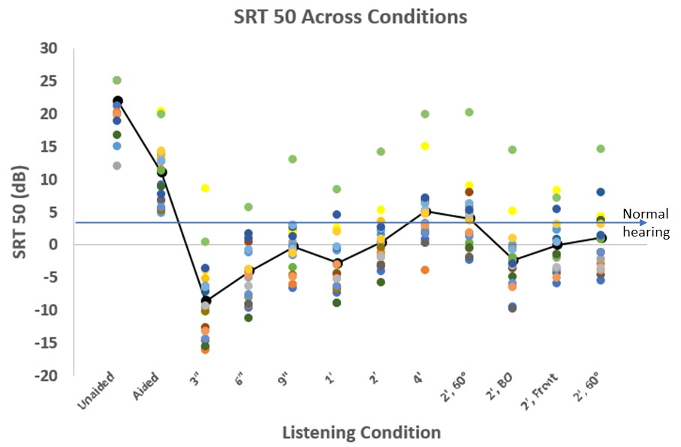
Figure 3. Required signal-to-noise ratios (SNRs) to achieve SRT50 for the various test conditions.
SNR benefit of Partner mic as a function of separation from source
The SNR benefit was measured as the difference between the SNR required for the HA+SA condition and the aided HA alone condition. Figure 4 shows the benefit of the Partner mic as a function of vertical distance from source loudspeaker. At a distance of 3 inches (7.6 cm) from the source (like wearing the partner mic at the collar), a SNR improvement of almost 20 dB was noted. At the 9-inch (22.8 cm) difference, the benefit was still 11 dB (limits of the length of the lanyard). A repeated-measures ANOVA showed a significant distance effect (F(2, 36) = 37.27, p < 0.001) and paired t-tests revealed that all distances were significantly different from each other (p<0.001).
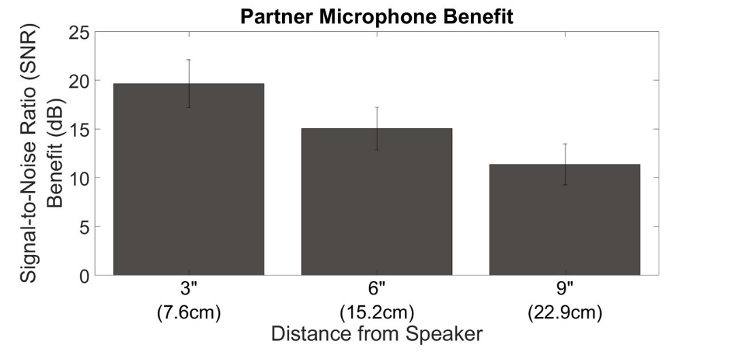
Figure 4. SNR benefit of the Partner mic as a function of vertical distance between the loudspeaker and the SA. Error bars denote 95% confidence interval.
SNR benefit of Tabletop mic as a function of separation from source
Figure 5 shows the SNR benefit of the Tabletop mic as a function of distance from the source loudspeaker. At a distance of 1 ft (0.3 m) from the source (closer than the typical placement at 2 ft or 0.67 m), a SNR improvement of almost 14 dB was noted. The benefit decreased to about 11 dB at the typical 2 ft (0.67 m) separation and to 6 dB at the 4 ft (1.2 m) separation. A repeated-measures ANOVA showed a significant distance effect (F(2, 36) = 54.74, p < 0.001) and paired t-tests revealed that all distances were significantly different from each other (p<0.001).
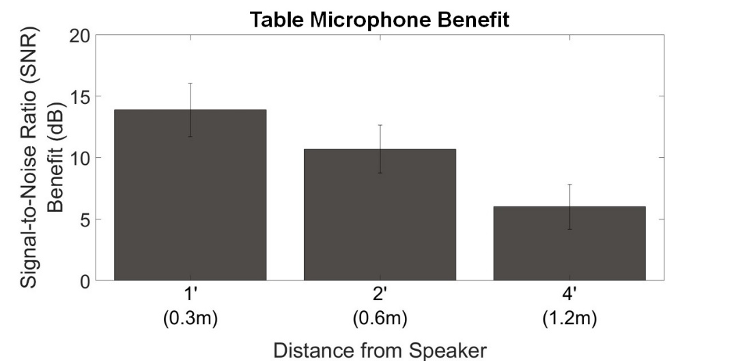
Figure 5. SNR benefit of the Tabletop mic as a function of horizontal distance between the loudspeaker and the SA. Error bars denote 95% confidence interval.
Relative efficacy of fixed vs adaptive mic in Tabletop mic mode
Figures 6 summarizes the SNR benefit of the Tabletop mic used in the fixed and adaptive modes when placed at a distance of 2 ft (0.67 m) from the target loudspeaker when the signal was presented from the front (left panel) and at the 60o azimuth (right panel). There was no advantage of the adaptive mic when the signal was presented from the front (t (18) = -0.551, p = 0.59); however, a 3-dB SNR advantage of the adaptive mic was noted when the signal was presented from the side (t (18) = -4.1, p < 0.001).

Figure 6. SNR benefit of the tabletop mic between fixed and adaptive mic modes with the signal presented from the front (left) and from the side (right). Error bars denote 95% confidence interval.
Effect of noise configurations (diffuse noise vs noise back)
Figure 7 compares the SNR benefit between the HA alone and HA+SA (Tabletop mic at 2 ft (0.67 m), fixed) conditions between noise conditions where the noise source behind the target speech loudspeaker was turned on (diffuse) and off (semi-diffuse). Removing the noise source behind the target source (i.e., semi-diffuse) improved the SNR by 2.7 dB over the diffuse noise condition (t(18)=-4.6, p < 0.001), suggesting potential improvement in SNR when noise near the target (or talker) was reduced.
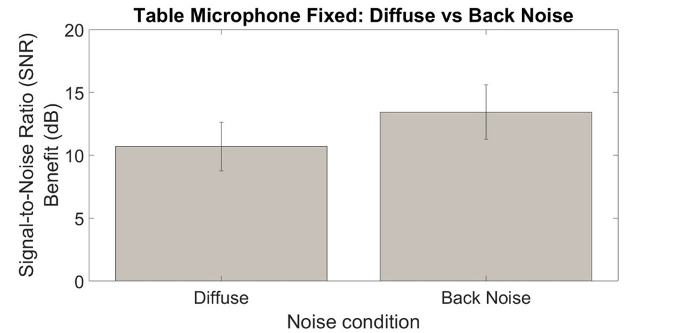
Figure 7. SNR benefit of the Tabletop mic in a diffuse and semi-diffuse noise field. Error bars denote 95% confidence interval.
Discussion
The current study demonstrated that by manipulating the distance between the RM and the target speech source (i.e., talker), by consistently using an adaptive mic on the RM, and by controlling the noise levels around the target speech source (i.e., talker), one could change the amount of SNR benefit offered by a RM.
The current study was conducted at a talker-listener (T-L) separation of 13 ft (4 m). This is different from many previous studies where the T-L separation was typically under 3 ft or 1 m (Thibodeau, 2014; Wolfe et al, 2020). The choice of the greater separation is because listeners in real-life do not always listen in such close proximity. When listening close to the talker, one can adjust one’s position (such as leaning forward) to reduce the distance effect and restore some audibility/SNR. On the other hand, the impact of adjusting listener body position will be negligible in improving the SNR over a far T-L distance, making this scenario a more likely case for RM technology. A separation of 13 ft (4 m) represents listening near the middle of a regular size classroom, or at the other end of a long conference table. We have shown that at this T-L separation, the average hearing-impaired listeners with a moderate-to-severe degree of hearing loss, even fitted with premium level hearing aids to the NAL-NL2 target, still required a SNR of 11 dB to follow 50% of speech. A higher SNR would be required if a criterion of 75% or 90% correct is used. The only solution to achieve such a high SNR is through the use of RM technology such as the Sound Assist device. Indeed, the farther the T-L separation, the greater the amount of benefit provided by RM.
The current study showed as much as (or over) 20 dB of benefit when remote microphones, such as the Widex Sound Assist, are positioned in proximity to the sound source. When the separation between sound source and the RM increases, benefit decreases, but not as rapidly as 6 dB per doubling of separation as predicted by the inverse square law in free-field (Rossing, 1990). Rather, the decrease varied between 3 and 5 dB as the separation doubled and as the noise floor of the room approaches. But even when the RM is set at 4 ft (1.2 m) from the sound source, an overall improvement of 6 dB was still achieved with the use of the RM. Thus, while one should always place the RM as close to the target speech as possible, one can be assured that significant benefit could still result even at 4 ft (1.2 m) separation between the source and the RM.
Practically, the Sound Assist RM should be used in the adaptive mic mode at all times to ensure consistency of audibility, unless one intends to block sounds from specific directions. Furthermore, if one can reduce the noise surrounding the target source, one can further improve the SNR from the target/source and the SNR required by the listener to perceive the target. While it was not tested in this study, reducing the noise surrounding the listener may or may not improve the overall SNR depending on the noise management strategies (NR and directional mic) used in the HA and the relative gain between the RM and the HA. This possibility needs further evaluation.
In all, RM is effective in improving the SNR (and intelligibility) of the listening condition over the HA-alone situation. The conditions where the RM is most effective would include (1) far separation between the target source and the listener, (2) close proximity between the RM mic and target source (3) minimal noise surrounding the target source (talker), and (4) consistent use of adaptive mic on the RM.
References
Boothroyd, A. (2004). Hearing aid accessories for adults: the remote FM microphone. Ear Hear, 25(1), 22-33.
Hawkins, D. (1984). Comparisons of speech recognition in noise by mildly-to-moderately hearing-impaired children using hearing aids and FM systems. J Speech Hear Disord, 49(4), 409-418. doi: 10.1044/jshd.4904.409. PMID: 6503247.
Jerger, J., Chmiel, R., Florin, E., Pirozzolo, F., & Wilson, N. (1996). Comparison of conventional amplification and an assistive listening device in elderly persons. Ear Hear, 17(6), 490-504.
Kuk, F., Slugocki, C., Ruperto, N., & Korhonen, P. (2020). Performance of normal hearing listeners on RRT with different noise configurations. Int J Audiol. https://dx.doi.org/10.1080/14992027.2020.1807626
Maidment, D., Barker, A., Xia, J., & Ferguson, M. (2018). A systematic review and meta-analysis assessing the effectiveness of alternative listening devices to conventional hearing aids in adults with hearing loss. Int J Audiol, 57(10), 721-729.
Rossing, T. (1990). The Science of Sound. Addison-Wesley, Reading MA.
Thibodeau, L. (2014). Comparison of speech recognition with adaptive digital and FM remote microphone hearing assistance technology by listeners who use hearing aids. Am J Audiol, 23(2), 201-210.
Watson, A. (2017). QUEST+: A general multidimensional Bayesian adaptive psychometric method. J Vision, 17(3), 10-10.
Wolfe, J., Duke, M., Schafer, E., Jones, C., Rakita, L., & Battles, J. (2020). Evaluation of a Remote Microphone System with Tri-Microphone Beamformer. J Am Acad Audiol, 31(1), 50-60. doi: 10.3766/jaaa.18065. Epub 2019 Aug 16. PMID: 31429403.
Wu, Y., Stangl, E., Chipara, O., Hasan, S., Welhaven, A., & Oleson, J. (2018). Characteristics of real-world signal-to-noise ratios and speech listening situations of older adults with mild to moderate hearing loss. Ear Hear, 39(2), 293-304.
Citation
Kuk, F., Korhonen, P., Slugocki, C., & Peeters, H. (2023). Maximizing the efficacy of the widex sound assist™ remote microphone. AudiologyOnline, Article 28761. Retrieved from https://www.audiologyonline.com





